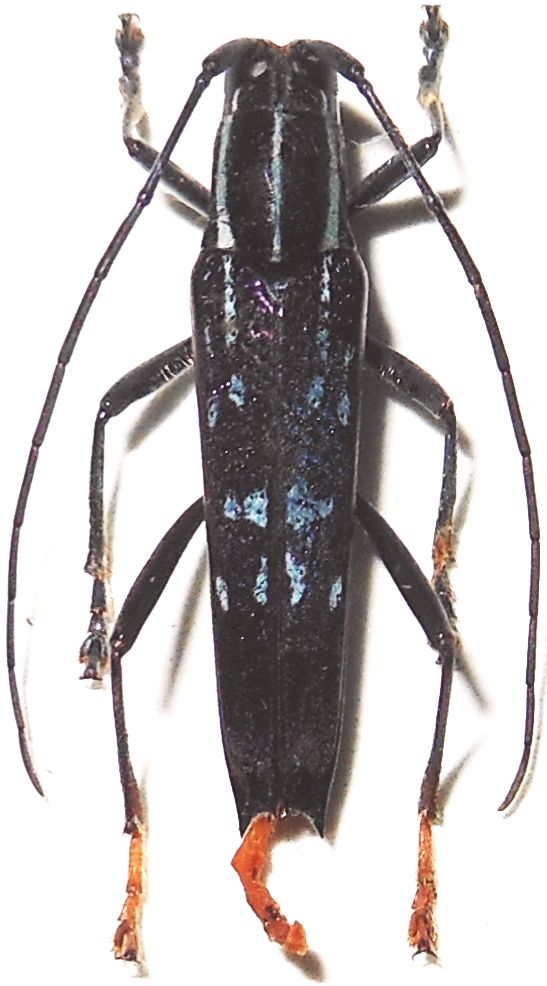| Author |
 Topic Topic  |
|
|
Robert
Member Rosenbergia
   
Canada
1249 Posts |
 Posted - 13/01/2021 : 02:37:05 Posted - 13/01/2021 : 02:37:05



|

130.03 KB
Bornéo, Sabah, Mont Trus madi, 23-III-2009.
16 mm. |
Robert V. |
Edited by - Robert on 14/01/2021 17:15:59 |
|
|
Xavier
Scientific Collaborator
    
France
12215 Posts |
 Posted - 13/01/2021 : 06:59:05 Posted - 13/01/2021 : 06:59:05



|
Glenea (Macroglenea) elegans (Olivier, 1795)?
I have never checked if it is really the same species in Laos, Philippines, Borneo, etc |
 |
|
|
Robert
Member Rosenbergia
   
Canada
1249 Posts |
 Posted - 13/01/2021 : 20:56:36 Posted - 13/01/2021 : 20:56:36



|
| Not sure if it is elegans. Might be something else. My specimen is more like this one, with the apical spots almost blending in with its surroundings. |
Robert V. |
 |
|
|
Bennyboymothman
Member Rosenbergia
   
United Kingdom
1647 Posts |
 Posted - 13/01/2021 : 21:25:20 Posted - 13/01/2021 : 21:25:20





|
| I think it's a new species, I will look into it further. |
 |
|
|
dryobius
Member Rosenbergia
   
USA
1887 Posts |
 Posted - 14/01/2021 : 12:23:54 Posted - 14/01/2021 : 12:23:54



|
I believe it is just G. elegans (very common in Sabah) and frequently with white pubescence rubbed off a little, or a lot.
G. elegans has a number of synonyms and seems to be very widespread (according to TITAN). It's unlikely that it is a new species, but there could be a number of very, very similar, closely related taxa. |
 |
|
|
Robert
Member Rosenbergia
   
Canada
1249 Posts |
 Posted - 14/01/2021 : 18:29:32 Posted - 14/01/2021 : 18:29:32



|
| Dan, do you have individuals that have the apical white spot on elytra almost as dark as the background, and the 3 sets of spots above with a blueish tinge? Do you have intermediate specimens? |
Robert V. |
 |
|
|
Francesco
Forum Admin
    
Luxembourg
9454 Posts |
 Posted - 14/01/2021 : 21:05:57 Posted - 14/01/2021 : 21:05:57




|
quote:
Originally posted by dryobius
G. elegans has a number of synonyms and seems to be very widespread (according to TITAN).
Actually, Titan quotes a number of erroneous localities (Laos, Philippines, New Guinea), where other species are present (venus and beatrix).
G. elegans should not be widespread beyond Malaysia-Borneo-Sumatra-Java.
This species is easily recognisable for its pronotum enlarged at base.
Possibly, some chromatic forms might be real subspecies or sibling species. |
 |
|
|
dryobius
Member Rosenbergia
   
USA
1887 Posts |
 Posted - 15/01/2021 : 02:53:43 Posted - 15/01/2021 : 02:53:43



|
Robert..
I have 8 specimens which I'm calling elegans. Some have very little white pubescence rubbed off, while a few have apparently lost some pubescence near the elytral apex; In addition, 2 specimens have lost the pubescent white line in the middle of the pronotum.
I could have two species, but I think it is slightly more likely that I just have one species.
I doubt if my answer helps you. Good luck. Maybe someday, somebody will study this group in its entirety. |
 |
|
| |
 Topic Topic  |
|


